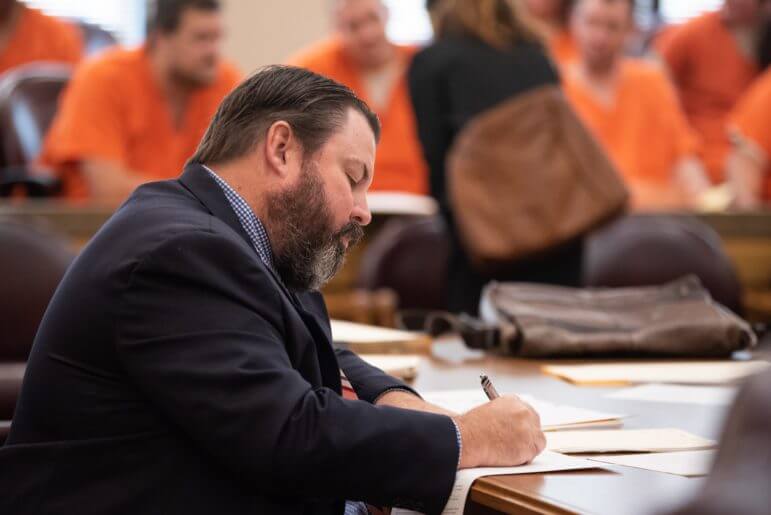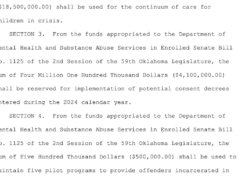

(Editor’s note: This story was authored by Trevor Brown of Oklahoma Watch and appears here in accordance with the non-profit journalism organization’s republishing terms.)
Kevin Finlay didn’t have long to discuss a legal strategy.
The court-appointed defense attorney spoke quietly with his client as they huddled in a Cleveland County courtroom Thursday. In less than 10 minutes total, the two looked over documents, outlined what to say to the judge and discussed the man’s various multiple charges in different jurisdictions.
The short conversation was not uncommon. Finlay often has to confer quickly with poor defendants who were assigned a public defender through the Oklahoma Indigent Defense System.
This is what Finlay calls legal “triage.”
“It’s akin to an emergency room doctor where you are just going room to room,” he said. If the patient is bleeding, “you stop that and then just have to run on to the next guy.”
Oklahoma’s indigent defense system is a state agency that seems perpetually on the verge of crisis.
The system provides representation for people who are accused of crimes but can’t afford a lawyer. But its leaders have repeatedly warned lawmakers that without more funding, the system may not be able to ensure Oklahomans’ right to legal counsel guaranteed in the U.S. Constitution.
Growing need
And numbers released to Oklahoma Watch show the agency just had its busiest year ever.
The system’s full-time and contract attorneys worked on 64,133 criminal cases during the 2019 fiscal year that ended June 30. That’s an increase of 4,000 cases, or 6.8 percent, from 2018.
The numbers for the past decade are even more striking.
The Oklahoma Indigent Defense System’s caseload has soared by more than 66 percent since 2009.
The latest increase in cases comes two years after voter-approved changes to state law that dropped many non-violent crimes from felonies to misdemeanors. The data showthat after the 2016 voter-approved reforms, the number of new felonies assigned to the system have fell in each of the last two years.
But the number of open cases the system carries over from the previous year continues to stack up – from about 9,400 in 2009 to almost 23,700 last year. And a new state law that makes it harder for judges to deny defendants a public defender is adding further strain.
“The caseloads just continue to climb,” said Craig Sutter, executive director of the Oklahoma Indigent Defense System. “It’s hard because once you get behind, it’s really hard to catch back up.”
What’s at stake
In a hearing with lawmakers last year, Sutter and other administrators of the Indigent Defense System were blunt about the consequences of inadequate funding.
Foremost among those was the potential inability of the system to meet the requirements set out in the U.S. Constitution, the leaders said in a document accompanying their budget request.
“This lack of funding will disrupt the entire criminal justice system and will expose the state to federal court intervention and civil monetary liability,” they wrote.
Insufficient funding also could lead to a reversal of convictions, release of people from custody and exposure of the state to allegations of federal civil rights violations.
Sutter said he doesn’t believe Oklahoma is at that point yet, but risks remain.
Funding increases of $1.3 million last fiscal year and $1.1 million for the current fiscal year have given the agency some needed breathing room. The extra money helped offset several years of budget cuts over the past decade and helped boost some salaries, including the hourly rate it pays private lawyers who work on contract.
But the high workloads have another consequence: Public defenders overwhelmingly convince their clients to accept plea deals instead of going to trial. Finlay estimated that about 98 percent of his cases end up being resolved through a plea deal.
Finlay said the trend is partly because many defendants want to avoid lengthy trials, during which they often remain in custody as their case slowly moves forward, and they can potentially be sentenced to a longer prison stay.
But he said this is also a consequence of how the Indigent Defense System is organized and funded.
“Ninety-eight percent is way too high,” he said, “and I don’t believe that’s how the system is set up to be.”
Although the agency appears to be able to fulfill its mission with its current funding, Sutter said it may need to reevaluate if caseloads continue to rise. And an even greater threat, he said, is the possibility that low oil prices or a recession will trigger a revenue emergency and lead to budget cuts like the ones that have plagued the agency before.
“That is what keeps me up at night,” he said.
A national problem
Oklahoma isn’t alone in struggling to make sure its indigent defense system is properly funded.
Lawsuits in other states, including Missouri and Louisiana, have challenged whether officials there are doing enough to support public defender programs.
A report released earlier this fall from the Brennan Center for Justice at New York University School of Law found that only 27 percent of county-based public defender offices, and 21 percent of state-based ones, have enough attorneys to adequately handle their caseloads. The researchers also noted that across the nation, public defenders’ salaries pale in comparison to those of private attorneys or the prosecutors they go up against.

Top among the group’s recommendations was to increase state funding for the public defender agencies.
“Public defenders protect the constitutional rights of millions of Americans, yet as a country, we invest so little in their work that they can’t do the job fully,” said Bryan Furst, the report’s author. “That has to change if we are going to improve how justice is served.”
Oklahoma County Public Defender Robert Ravitz, whose agency, like Tulsa County’s, is not part of the state indigent defense system, said one of his top challenges is recruiting and retaining attorneys who most likely can find better pay elsewhere.
“I lose an average of 15 to 20 percent of my lawyers each year,” he said.
Mixed results
But it’s not all bad news.
The latest numbers show that State Question 780, which passed in 2016 and reduced many non-violent offenses and drug charges to misdemeanors, has cut felony filings during each of the two years the law has been in effect.
At the same time, the number of misdemeanor cases has risen sharply, by 46 percent over two years.
This mirrors a recent report from the Oklahoma Policy Institute, an advocacy and research group, that found misdemeanors began climbing while felonies began dropping starting in 2017.
Finlay, who works out of the indigent defense system’s Cleveland County office, said even though felonies typically require more time and attention than misdemeanors, the higher numbers still place a strain on attorneys such as himself.
But he said the challenges would be far greater if the state question hadn’t passed.
“Our caseload would be insurmountable,” he said. “We would have no hope of keeping up at that point.”





















